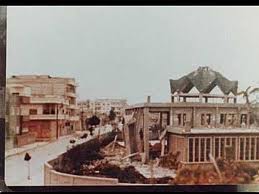We went back to Hama after our first post-massacre visit. Three weeks later, the magnitude of destruction had become more apparent.
The Kilani district had been flattened, and a brick wall was being built around it. Hafez al-Assad banned survivors from the historic site from returning to their homes. Rumors spread that a hotel would be erected over the site. (It was completed years later.) My father’s and grandmother’s graves in their once sacred cemeteries were to disappear with thousands of others, as public, stepped parks were planned to take their place. The Azm Palace, which was built in the eighteenth century and was the official museum of the city, was severely damaged. Its iconic red dome was half destroyed, and its treasures were looted. Because of extensive damage, the museum was temporarily moved to Abulfida Mosque, one of three surviving mosques in various states of damage. The Grand Mosque—considered the most ancient site in the city, if not the entire country—had been reduced to a heap of rocks after an Assad general had decided its fate so.
Unlike our first visit three weeks ago, we saw people walking down the streets of Hama. We reached a big crowd watching the demolition of the largest new cathedral. This cathedral and the Grand Mosque were detonated simultaneously at the end of February. The two explosions, according to many accounts, severely shook the city. One arch of the cathedral’s huge edifice was resistant to a bulldozer`s many attempts to destroy it. We were standing along with the priest in his traditional black dress until the arch fell, stirring a massive cloud of dust. We passed by a public bath from the Ottoman era, where an unknown number of women had been kidnapped, raped, and killed by Assad soldiers. An eerie feeling overcame me every time I walked by, sneaking into the dark depths of the locked and deserted building.

The people of Hama differentiated between two elements of Assad’s forces: on the one hand, the regular army, and on the other hand, the Defense Brigades and Special Forces. The latter had committed most of the atrocities. You could see their insignia spray-painted on the walls everywhere. Most of the forty thousand killed in Hama were systematically massacred not by air and ground bombardment, but after Hafez al-Assad’s forces took control of the city district by district. An unknown number of children were transferred to specific mosques in Homs and Aleppo—for adoption. The booty from looted houses was used to furnish the houses of Assad’s generals and soldiers or was placed for sale in other towns.
Hama was gradually transformed. Street lights were glaring, and the roar and whistles of construction machines infiltrated the city’s calmness. Minarets were still absent from its skyline. The city’s destruction was so obvious that it seemed Assad wanted to warn the rest of Syria of what could be a similar fate.
By the time summer arrived, the famous water wheels were rotating once again. A feeling of normalcy prevailed, though disrupted with more flattened areas on the city map.
Ramadan was in the summer that year, and the mosques were cleaned of the aftermath of destruction. Small rooms or courtyards with no roofs were prepared for Ramadan nightly prayers. The crowded mosques gave a false reassurance that the number of people who had been killed was not that high. We wanted to have that false hope as well, but the wintery end of the year proved otherwise. The city by then appeared deserted. Many were slaughtered; many fled abroad; and remaining residents took refuge in neighboring towns and villages, mainly Homs. Only the unable stayed.
Even the dairy products that Hama was famous for were redirected to Homs and other towns. Hama is known for its cheese, yogurt, and ghee, but not during the year after the massacre. It was heart-wrenching to see that familiar market places were no longer there. The faces of people were clearly burdened with what they observed. Their heavy silence spoke volumes.
The city was literally empty. When the cold nights of the first winter arrived, we realized the heavy toll the city had paid for its quest for freedom. The first sentence to greet somebody was, “Inshallah, no family member is lost?” or “What detention camp were you at?” Still, the stories of atrocities, rape, and torture circulated in whispers among people and kept circulating, like the ever-turning waterwheels of Hama, until now.
"God punish the one behind it," was a sentence that I heard a lot of Hamwis reiterate but refuse to elaborate upon. I knew they would never forgive Assad`s atrocities. But they were also not happy with the opposition they had wholeheartedly embraced because of their mismanagement of the conflict. The sacrifice was huge, with no immediate tangible outcome.
Still, Hama is a fire alit beneath the ash. Years will never extinguish it. All the details are in the collective memory of Hama’s populace. None will be lost. Hama is just waiting for the Day of Reckoning. Then, and only then, we will know the magnitude of the savagery of the Assad family, a savagery that took the Syrian people by surprise. The surprise was so shocking, it has taken us a generation to wake up and rise again.